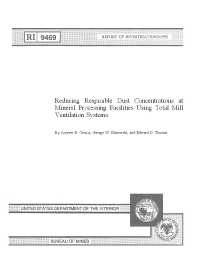Mining Publication: Reducing Respirable Dust Concentrations at Mineral Processing Facilities Using Total Mill Ventilation Systems
Original creation date: January 1993
The U.S. Bureau of Mines has designed and evaluated total mill ventilation systems at two different mineral processing operations. Both systems have proven very effective at reducing respirable dust levels throughout the mill in a cost-effective manner. A 25,500-cfm system installed at a clay processing mill provided approximately 10 air changes per hour. This system reduced respirable dust concentrations by approximately 40 pct throughout the mill building. The second evaluation was performed at a silica sand operation. Tests were performed with 50,000 and 100,000 cfm of ventilation to the mill building, corresponding to 17 and 34 air changes per hour. Average mill-wide respirable dust reductions were 36 and 64 pct, respectively. Not only did these systems reduce respirable dust concentrations and increase visibility throughout the mills, they were also easy to install and required minimal maintenance. A total mill ventilation system provides a general purging of the mill air; the system should be viewed as a supplemental technique to assist other dust control systems in operation.
Authors: AB Cecala, GW Klinowski, ED Thimons
Report of Investigations - January 1993
NIOSHTIC2 Number: 20025028
Pittsburgh, PA: U.S. Department of the Interior, Bureau of Mines, RI 9469, 1993 Jan; :1-11
See Also
- Best Practices for Controlling Respirable Dust in Coal Mines
- Control of Respirable Dust
- Dust Underfoot: Enclosed Cab Floor Heaters Can Significantly Increase Operator's Respirable Dust Exposure
- The Effects of Water Spray Placement for Controlling Respirable Dust and Face Methane Concentrations
- Evaluation of the Approach to Respirable Quartz Exposure Control in U.S. Coal Mines
- Improved Drill Shroud Capture of Respirable Dust Utilizing Air Nozzles Underneath the Drill Deck
- Improving Silica Dust Control Through Targeted Research
- Laboratory Testing To Quantify Dust Entrainment During Shield Advance
- Performance of a Light Scattering Dust Monitor at Various Air Velocities: Results of Sampling in the Active Versus the Passive Mode
- Research by NIOSH for Controlling Respirable Dust and Methane Gas on Continuous Miner Faces
- Content source: National Institute for Occupational Safety and Health, Mining Program


 ShareCompartir
ShareCompartir
